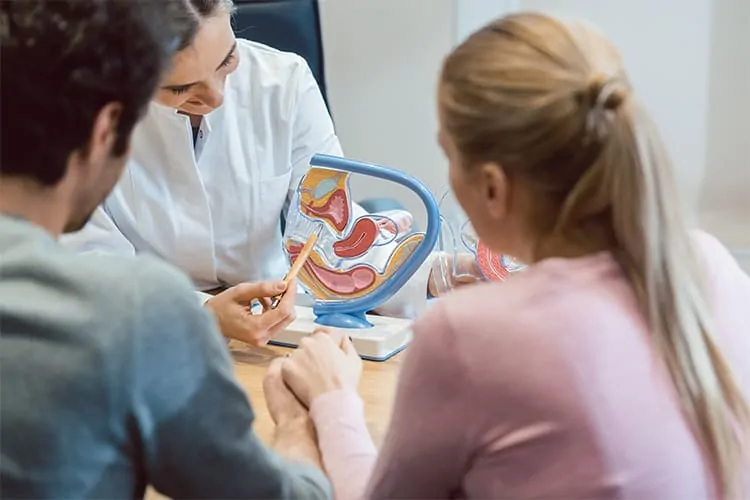Past the age of 35 a woman's egg release decreases significantly which is one of the main reasons for female infertilty alongside endometriosis, fibroids, tubal blockage, and the hormonal imbalance. Read the article if you want more details on these causes.
Causes of Female Infertility
Women receive the majority of attention during a fertility evaluation. In part because there are more established diagnostics and treatments for females to achieve pregnancy and because females, once pregnant, need to maintain the pregnancy to delivery. There are a number of key causes for female infertility issues.
Age and infertility
The age at which women will have their first child has increased in past decades in the U.S., with similar trends seen in many European countries. With age comes declining fertility because a woman’s ovary has less eggs available to be matured; also, as she gets older, so do her eggs, which means they have more chromosomal (genetic) problems. Even though women often continue to have regular menstrual cycles past the age of 35, the actual percentage of cycles that an egg is released (ovulatory cycles) decreases significantly. Even when a woman’s menstrual cycle (her period) is fairly regular, the hormones that regulate ovulation change and if tested, may be able to tell us if she is approaching her menopause. So this means that as women get older yet are still getting a period, there may be a false belief that she is still as fertile as she had been when she was younger.
Endometriosis and fibroids
Endometriosis is not uncommon, with some estimates of 10–15% of all women of reproductive age and >30% of the infertile women. Uterine fibroids (i.e., leiomyomas or myomas) are benign (not cancerous) tumors in the muscle of the uterus (womb) and are very common. Having a fibroid can sometimes impact your fertility, as well as your quality of life due to very heavy menstrual bleeding and pelvic pain. Sometimes these conditions improve with surgery and it is very important to be assessed by your physician if you have either. In many cases though, having a fibroid will not affect your chance of getting pregnant and you also may not necessarily have any symptoms from one, if it is there.
Tubal blockage
Fertilization occurs in the fallopian tubes. When they become damaged or blocked (sometimes because of scarring that happens after an infection), there can then be a physical barrier that prevents sperm from meeting the egg.

The biggest contributor to tubal blockage is pelvic inflammatory disease which is a serious complication of sexually transmitted infections (STIs), such as chlamydia and gonorrhea. In addition to tubal blockages contributing to infertility, they can also increase the risk of a tubal (ectopic) pregnancy. . If your physician thinks that you may be at risk of having blocked tubes they may arrange tests or procedures to see if they are open or not. Sometimes these tests are done in an x-ray department (hysterosalpingogram or HSG-see below). On other occasions your doctor may recommend that the tube and pelvis be examined under anesthesia with a fine telescope (laparoscopy) to check that the tubes are open. Having blocked tubes does not mean a woman cannot become pregnant or have a healthy pregnancy. However, she will need to be seen by a specialist who can recommend treatments such as IVF (in vitro fertilization).

Hormonal imbalance
The complex coordination of hormones that affects the reproductive cycle in a woman can be affected by certain conditions. When this happens, ovulation (releasing an egg) can be affected. Polycystic ovarian syndrome (often called PCOS) is the most common reproductive hormone problem that can affect reproductive-aged women. Risk factors for PCOS in adults includes both type 1 and type 2 diabetes and gestational diabetes. When a woman’s ability to ovulate is affected by abnormal hormones, it is very important to have a fertility expert working with her when she is trying to become pregnant.
Female evaluation
In addition to a complete history and physical examination by the healthcare provider, several basic tests can be done that might help understand a potential cause of the fertility issue.
Tests that are commonly done include blood tests like Follicle Stimulating Hormone (FSH) and luteal phase progesterone to see if the ovaries are working normally and releasing eggs, as well as tests to see if a woman’s ovaries are likely to respond well to IVF treatment (Antimullerian Hormone or AMH). Additionally, a small probe may be placed inside the vagina to look at the ovaries with ultrasound and to count the number of follicles that can be seen.
The standard test to see if the fallopian tubes are blocked is a hysterosalpingogram (HSG). In this test, radiopaque dye is injected through a very small tube through the cervix (the opening of the uterus) under fluoroscopic imaging. This helps providers visualize the uterus and fallopian tubes, and can give information about uterine filling defects and contour/shape abnormalities.
Based on the results of hormonal and fallopian patency tests, more complicated tests might be needed, including laparoscopy, hysteroscopy, and hysterosonography. It is important to work closely with the health care team and ask questions to understand what test would be most appropriate and how to prepare for each of the test. In this article, you can read more about how lifestyle also affects female fertility.
If you want to read more about women´s anatomy and their reproductive system, we can recommend following the link to our article on the subject.



